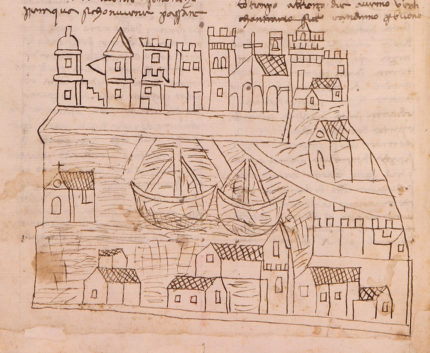A pen and ink drawing in a 14th century travelogue is the oldest known city view of Venice. The image was drawn by Niccolò da Poggibonsi, a Franciscan friar who made a pilgrimage to the Holy Land and Egypt in 1345-50, in his account of his travels now in the Biblioteca Nazionale Centrale in Florence. He wrote his travelogue the Libro d’oltramare, after his return to Italy. While the manuscript has been published before, the drawing has not. It was identified by Dr. Sandra Toffolo from the University of St Andrews’ School of History.
When Dr Toffolo discovered the image, she realised that the city view of Venice predates all previously known views of the city, excluding maps and portolan charts. The oldest extant map of Venice was made by Fra Paolino, a Franciscan friar from Venice, and dates from around 1330. Since the discovery, Dr Toffolo has spent the last several months verifying the image through consulting books, manuscripts and articles.
A series of small pinpricks discovered on the original manuscript image also suggests that the city view was more widely circulated. This technique was used to copy images: powder was sifted through the pinpricks onto another surface, thereby transferring the outlines of the image.
Dr Toffolo said: “The presence of these pinpricks is a strong indication that this city view was copied. Indeed, there are several images in manuscripts and early printed books that are clearly based on the image in the manuscript in Florence.
Niccolò left Poggibonsi in Tuscany in March of 1345 and went through Florence, Bologna, Ferrara, Chioggia before arriving in Venice. It’s the first city he writes about it in detail. Since his epic voyage was a pilgrimage, Venice gets air time for its many holy relics.
“In this city there are many saints’ bodies, like of Saint Mark the Evangelist, even though it’s not on display. But I saw the whole body of Saint Lucia and of Saint Zechariah, father of John the Baptist, whole and entire, and Saints Cosmas and Damian, and the foot of Saint Mary of Egypt, and saw the thigh bone of Saint Christopher and I measured it — it was from hip to knee four spans long — and other saints’ bodies did I visit.
But the city itself made a big impression with the traveler. The canal system even got its own chapter.
This is a noble city, and it sustains itself better as a community than any other place in the world, and all the men are merchants and the women work by hand, because every necessity of life they have to bring in from the outside for money. The reason is because Venice is all in the sea, has no land around it where they might harvest grain or other to live off of.
Regarding this land, meaning Venice, it is made differently from other places in that the whole city there are no streets on land. Their streets, small and large, are canals of water, and so by water, ie, by boat, one travels everywhere. […] And the city is full of beautiful houses with many bell towers that are so tilted that it seems they’ll fall from the bad foundations. They can’t make better ones because of the sea.
I think it is the most regal port in the world where you can always find ships to navigate anywhere in any country a man has business to visit.
